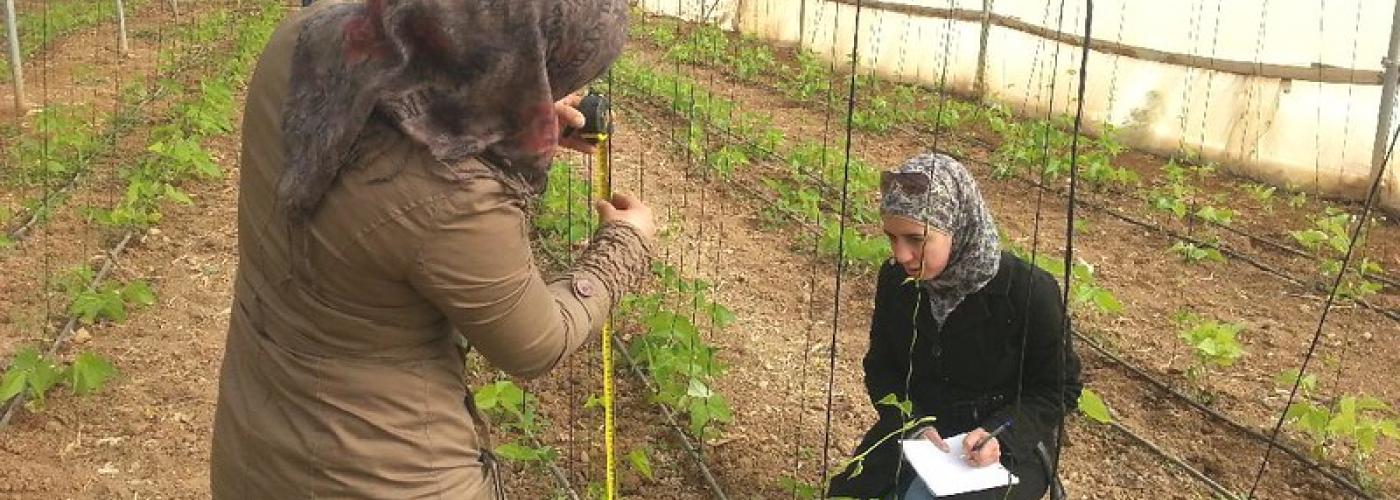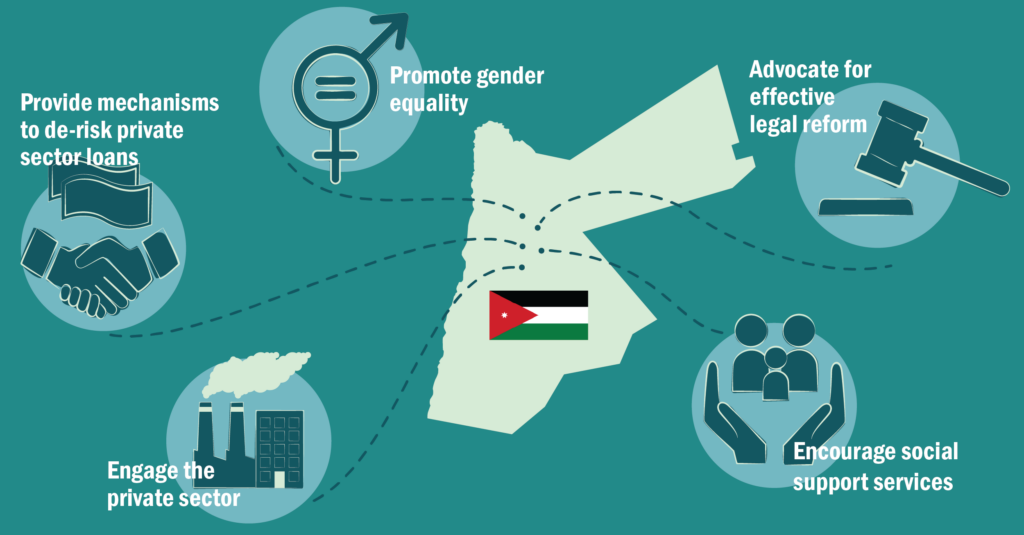Women's Economic Empowerment and the Path to Prosperity in Jordan
Image

To strengthen economic prosperity in the Kingdom of Jordan, bolster female employment. Clearly, the need exists: Labor market inclusion for Jordanian women is among the lowest in the world. The World Economic Forum’s Global Gender Gap Report 2020 ranked Jordan 138th out of 153 countries on relative gaps between men and women in health, education, economics, and politics, even though Jordan has the highest rate of female literacy (97 percent) in the Middle East. But Jordanian women’s education has yet to translate into job opportunities, and that carries enormous implications, namely forfeited economic growth. Addressing this gap should be the priority of all future international development aid to put Jordan on a sustainable path to economic recovery and prosperity.
“Closing the gender gap in Jordan’s labor market could increase GDP by more than 20 percent.”
-Allison Jacobs Anderson, Washington Institute for Near East Policy
Jordan is poised to accomplish this. The kingdom has enacted numerous reforms that have helped the country withstand multiple economic shocks over the past decade, including the influx of 1.3 million Syrian refugees beginning in 2011 and now the downstream effects of the COVID-19 pandemic. A large part of Jordan’s resilience in the face of crisis lies in its commitment to economic reform.
For example, consider the 2016 Jordan Compact, a new approach for dealing with refugees: In return for providing education and legal employment for Syrian refugees, a UK-led compact, with support from the World Bank, gave Jordan billions of dollars in grants, loans, and favorable trade agreements with the European Union.
And in 2019, Jordan jumped an unprecedented 29 positions from the previous year in the World Bank Group’s (WBG) Doing Business 2020 rankings.
“The fact that Jordan is this year among the world’s top-10 reformers is a milestone.”
-Dalia Wahba, IFC Manager of the Levant
Development support designed to strengthen Jordan’s small and medium private-sector enterprises is an important key to sustainable prosperity in the kingdom; these businesses make up 97 percent of its private sector economy and employ around 60 percent of the labor force. While the most recent economic reforms have improved the legal rights of borrowers and lenders and cut red tape for business owners, they have yet to address the problem of low female employment in a comprehensive and systemic manner. Only 14 percent of Jordanian women are engaged in the formal economy, with an estimated additional 15 percent working in the informal economy. And less than 10 percent of Jordanian businesses are owned by women.
Development assistance falls far short of its potential effectiveness when at least 80 percent of Jordan’s intellectual capital are omitted. Moving forward, international development donors, especially the U.S. Agency for International Development (USAID), should prioritize a comprehensive approach – social, cultural, economic, and legislative – toward removing the barriers to women’s participation in the labor market. The Agency’s mandate to engage the private sector in all its programming through its Private Sector Engagement Policy, coupled with the U.S. government’s emphasis on prioritizing women’s economic empowering in development assistance set out in the Women’s Global Development and Prosperity Initiative (W-GDP), creates a logical direction for future USAID assistance in Jordan: Seek ways to collaborate with the private sector to boost female employment with a comprehensive approach.
WHAT THE RESEARCH SAYS
A substantial body of qualitative and quantitative studies on female employment exclusion and its ramifications in Jordan all seem to corroborate each other’s findings. The causes range from social norms to legislative structural barriers; the end results are lost opportunities for personal fulfillment for Jordanian women, squandered social benefits for Jordanian families and communities, and forfeited revenue for Jordan’s economy.
Allison Jacobs Anderson, a leading expert on Jordanian female employment and a former 2018-2019 Fulbright Research Fellow in Jordan, writes that increasing female employment will help to “accelerate economic growth and foster an economy less susceptible to crises.” Anderson’s research found that, “legal restrictions, difficult transportation infrastructure, lack of acceptable jobs, low access to childcare facilities, and societal norms that cast women as homemakers and caregivers” make up most of the structural barriers that prevent Jordanian women from finding work outside the home. Removing these barriers to allow for an inclusive labor market would increase Jordan’s GDP by more than 20 percent.
Likewise, researchers in Harvard’s Center for International Development 2019 report, “Female Labor in Jordan: A Systematic Approach to the Exclusion Puzzle,” found that traditional social norms and poor public transportation were the chief barriers preventing women with a high school education or less from participating in the workforce. For women with university degrees and higher, unemployment was attributed to an “undiversified private sector that is unable to accommodate women’s needs for work and work-family balance.” In other words, a significant portion of the Jordanian population divides professions into “male jobs” and “female jobs,” and adequate child-care facilities are unavailable.
“Female empowerment is achieved when women and girls acquire the power to act freely, exercise their rights, and fulfill their potential as full and equal members of society. While empowerment often comes from within, and individuals empower themselves, cultures, societies, and institutions create conditions that facilitate or undermine the possibilities for empowerment.”
-Harvard Center for International Development
This confirms a comprehensive quantitative study published by the World Bank in 2018 that measured the extent to which Jordanian social norms and beliefs impacted women’s access to and participation in the labor market. The groundbreaking study revealed the barriers faced by Jordanian women seeking job opportunities and offered recommendations to address the constraints. Here’s just a few of the topline findings:
- Almost two-thirds of non-working Jordanian women want to work outside the home.
- Almost two-thirds of Jordanian men admitted they disapprove of women working outside the home.
- Both men and women agreed that men are the ultimate decision makers in the household.
- Working married women underestimated how disapproving people – particularly men – are of married working women returning home after 5:00 p.m.
- Forty-four percent of respondents believed that working women are exposing themselves to harassment, limiting the types of work women can take up (i.e., not a mixed-gender workspace).
- Most all respondents believed children should be around 4.5 years old before a mother can leave them in a daycare (or elsewhere) to go to work, delaying a women’s re-entry into the labor force to the point she won’t return at all.
The World Bank study overall suggests that the largest constraint to female employment is men’s strong disapproval of women working outside the home, negative attitudes about men and women working together, a strong disapproval of women returning home after 5:00 p.m., and men’s beliefs about the types of work suitable for women.
WHY INCLUSIVENESS MATTERS
A United Nations report establishes that women’s economic empowerment is “central to realizing women’s rights and gender equality.” Empowering women in the economy is also key to achieving the 2030 Sustainable Goals. When more women work, families and communities thrive. Economies grow and prosper. Economically empowered women use their voice to demand better schools and health services and are often more inclined to be politically active which leads to a reduction in violent extremism.
In the U.S., the U.S. Development Finance Corporation (DFC) prioritizes women’s economic empowerment to foster global prosperity and stability. “We know that women are key to both,” said Laura Allen, a DFC spokesperson. “By addressing the challenges they face – including a roughly $300 billion shortfall in access to credit – women could add an estimated $28 trillion to global GDP by 2025,” she said. Through the 2X Women’s Initiative, DFC invests in businesses and funds owned by women, led by women, or provides a product or service that intentionally empowers women, such as clean water and quality healthcare.
In 2019, the White House established the Women’s Global Development and Prosperity Initiative (W-GDP) to push women’s economic empowerment to the forefront of the U.S. government’s development agenda. It’s the first-ever, whole-of-government approach to women’s economic empowerment, directing partner U.S. agencies, including the Departments of State and Labor as well as the DFC, to prioritize action to address the legal and societal barriers to women’s economic empowerment. The W-GDP states global GDP would grow substantially if the same number of women as men participated in the global economy, and that low female employment in developing countries impedes economic growth and poverty reduction. USAID manages the W-GDP Fund, where it has secured partnerships with private sector companies, UPS, PepsiCo, Mars, and MasterCard, to collaborate and scale-up more than 200 W-GDP funded projects in 20 countries.
“The larger the opportunity gap between men and women, the more likely a country is to be involved in violent conflict. Conversely, nations in which women have equal opportunities are more likely to thrive and solve challenges peacefully.”
-Women’s Global Development and Prosperity Initiative
USAID Jordan’s development programming aims to reduce gender disparities in Jordanian society and its economy. Past USAID successes include backing the Government of Jordan’s adoption and implementation of the Flexible Working Hours Bylaw to encourage women’s economic participation in civil society. The law, however, does not support women in leadership positions. USAID has also supported four years of online media debates and conversations around gender priorities in Jordan on Facebook, Twitter, and YouTube. As of January 2020, USAID reported more than 1.6 million online dialogues aimed to foster gender inclusiveness in Jordanian society.
“USAID aims in all of its programming in Jordan to reduce gender disparities and empower women and girls to realize their rights, determine their own life goals, and help strengthen their communities.”
- USAID
But the recent findings in an evaluation of the 5-year USAID Jordan Local Enterprise Support Project (USAID LENS), designed to improve women’s economic participation through the use of information and communication technologies (ICT), revealed that “access to and use of ICTs in and of itself for these economic activities is not sufficient to overcome the numerous structural obstacles to women’s economic participation.” Based on these findings and in light of the collective research above, the evaluation recommended a “comprehensive approach” to support women’s participation in Jordan’s economy and “multiple interventions” geared to addressing the social norms that limit women’s ability to work outside the home and participate in Jordan’s economy.
WHY JORDAN MATTERS
The international donor community has a stake in Jordan’s economic health. Due to the Syrian refugee crisis, supporting Jordan’s economy is a high priority for the European Union. Jordan is also a key U.S. partner in the Middle East; the two countries collaborate in global counterterrorism operations and collectively seek to empower moderates and reduce sectarian conflict in the region. Improving economic inclusivity in the kingdom is not only good for Jordan but also for the region and the world.
The World Bank announced a $1.45 billion financing package in 2019 to help Jordan achieve gender parity and stimulate inclusive growth. The announcement referenced Jordan’s commitment to increase women’s participation in its labor market, including: the kingdom’s plan to reach 24 percent female participation by 2025; new legislation that promotes flexible working hours; more workplace child-care facilities; and new codes that address harassment in the workplace and in the public transportation system.
More recently, on May 5, 2020, the United States and Jordan signed development assistance agreements totaling $340 million dollars, part of the overall $1 billion in USAID’s budget for Jordan in FY 2019. As USAID begins to award these funds for projects aimed at improving Jordan’s economy, comprehensive approaches for women’s economic participation offer the greatest impact based on the most current research and in alignment with U.S. development aid priorities. These awards should also support the women’s empowerment goals in the USAID 2020-2025 country strategy for Jordan, now under development.

Below are a few recommendations that international donors, and USAID in particular, might consider based on the research cited above. Taken together, they offer a comprehensive approach toward removing the obstacles that prohibit women’s participation in Jordan’s economy:
Engage the Private Sector
The USAID Private Sector Engagement Policy is an Agency-wide mandate to collaborate with the private sector to design and deliver USAID development and humanitarian programs across all sectors. Here’s a few ideas:
- Emphasize private sector engagement strategies in the USAID Promoting Women’s Equality and Women’s Empowerment/Jordan initiative. Currently it emphasizes partnership with the Government of Jordan. That’s important, but legislation alone will not prevent and remove gender discrimination.
- Facilitate policy fora and discussions between appropriate Jordanian ministries and the private sector to discuss the challenges faced by women in the labor market.
- Reach out to both U.S. and Jordanian companies with a pitch to co-create employment campaigns that encourage women to apply for nontraditional positions. Co-create internships with these same companies for girls and college students to explore nontraditional career roles.
- Co-create an innovative impact investment fund that’s fully managed by the private sector and targets women-owned businesses in a manner accomplished USAID/Brazil Mission.
Provide Mechanisms to De-risk Private Sector Loans
Research points to capital as the largest constraint to growth for small firms. Blended finance interventions and the strategic use of development funds to mobilize private capital can mitigate the risks associated with loans. Specific tactics include:
- Employ blended finance interventions to encourage private investment in women-owned businesses, especially the establishment of private daycare centers.
- Inject catalytic capital into loan structures USAID co-creates with the private sector for women-owned businesses.
- Extend financing to women-owned small and growing businesses through GroFin in a manner similar to the recent USAID facilitated project in northern Iraq.
- Increase opportunities for women to access information and communication technologies (e-banking or e-wallets) to establish digital financial services as well as establish women’s control of financial resources.
Promote Gender Equality
USAID can strengthen and expand its existing programs that promote women’s economic empowerment and challenge the stereotypes that keep women at home. For example, Anderson recommends USAID take “a careful look at gender bias in Jordan’s school curricula.” Here are some other activities:
- Co-design programs with Jordan’s education ministry that promote women in nontraditional careers.
- Work with the Chamber of Commerce in Jordan to promote women’s economic empowerment.
- Seeks ways to establish digital technology channels and platforms for women, as digital financial services (DFS) are a critical factor in helping women gain access to finance and cash and voucher assistance.
Advocate for Effective Legal Reform
Jordanian laws, including its labor laws, discriminate against women. Remedies include:
- Advocate to amend Article 72 of the Jordanian Labor Law to provide on-site childcare facilities to both men and women who have children under the age of four. This will eliminate the extra costs associated with hiring married women as well as to help promote the notion that childcare is a shared responsibility among both men and women rather than the sole responsibility of women.
- Facilitate Article 72 amendment conversations between the appropriate Jordanian government ministries and the Jordanian private sector.
Encourage Social Support Services
Lack of adequate daycare and unsafe public transportation are both widely viewed as obstacles that prevent women from working outside the home. Possible solutions include:
- Provide USAID grants or other blended finance interventions with the private sector to support the development of women-owned daycare centers.
- Support advocacy groups, civil society organizations, and local government bodies to improve safety on public transportation and enforce harassment codes.
THE PATH FORWARD
Improving the economic participation of women in Jordan will lead to numerous positive outcomes for women personally as well as for Jordanian families and communities as a whole; it will foster resiliency, stability, sustainable economic prosperity and self-reliance in the kingdom. One fact that merits consistent emphasis in donor interventions is the value-added to the Jordanian economy by including women in all sectors of the labor market. New business opportunities and jobs for women will not result in a loss for men – a faulty zero-sum economic perspective. Rather an increase in female employment will improve efficiency and competitiveness in Jordan’s labor market and more women entrepreneurs will create job opportunities to bolster the kingdom’s GDP at a time when Jordan needs them the most.
In a June 29, 2020 Center for Strategic and International Studies interview with Jordan’s minister of finance Mohamad al-Ississ, the minister emphasized that his government was “pushing an intense reform agenda economically,” even as the kingdom addressed the COVID-19 pandemic. Due to the country’s swift and comprehensive lockdown and its strong public health care system, as of July 16, 2020 only ten people have died from the deadly COVID virus in Jordan. The cost to its economy, however, has been high. After growing 2 percent in 2019, analysts predict that Jordan’s GDP will contract by 3.5 percent in 2020.
Nonetheless, al-Ississ emphasized that Jordan will continue its ambitious economic reforms. He believes the kingdom’s swift response to the COVID crisis earned the government immense political capital to implement the necessary reforms and deliver “on the moderation and stability that Jordan symbolizes.”
And that must include economically empowering women in Jordan.
“We want to improve the workplace for our women, and there is no shortcut to that. The only path forward is through hard, deep, structural reform.”
-Mohamad al-Ississ


